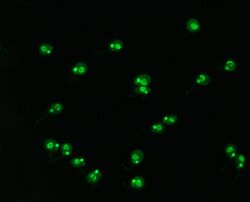Biology:Crithidia luciliae
| Crithidia luciliae[1] | |
|---|---|

| |
| Immunofluorescence staining pattern of anti-dsDNA antibodies on C. luciliae substrate. The kinetoplast, located near the flagellum, is stained, indicating the presence of anti-dsDNA antibodies in a person with SLE. | |
| Scientific classification | |
| Domain: | Eukaryota
|
| (unranked): | |
| Phylum: | |
| Order: | Kinetoplastida
|
| Family: | |
| Genus: | |
| Species: | C. luciliae
|
| Binomial name | |
| Crithidia luciliae | |
Crithidia luciliae is a flagellate parasite that uses the housefly, Musca domestica, as a host.[2] As part of the family of Trypanosomatidae, it is characterised by the presence of a kinetoplast, a complex network of interlocking circular double-stranded DNA (dsDNA) molecules. The presence of the kinetoplast makes this organism important in the diagnosis of systemic lupus erythamatosus (SLE). By using C. luciliae as a substrate for immunofluorescence, the organelle can be used to detect anti-dsDNA antibodies, a common feature of the disease.[3][4]
Taxonomy
C. luciliae is a eukaryotic single-cell protozoan. The family Trypanosomatidae belongs to the order Kinetoplastida and is characterised by the presence of the kinetoplast, a network of interlocking circular DNA in a large mitochondrion. All organisms in Kinetoplastida are parasitic, and the host organism for C. luciliae is the housefly, Musca domestica.[5][6][7]
Role in systemic lupus erythematosus diagnosis
The kinetoplast found in C. luciliae allows them to be used for the detection of anti-dsDNA antibodies, a type of anti-nuclear antibody. Anti-nuclear antibodies are a common feature in SLE, and anti-dsDNA antibodies are highly specific for the disease. The high concentration of dsDNA and the absence of human nuclear antigens in the kinetoplast provides a specific substrate for the detection of anti-dsDNA antibodies.[4][8]
Purine nucleotide and nucleobase uptake
As a parasitic protozoan, C. luciliae lacks the ability to biosynthetically produce purine bases and therefore needs to salvage them from the surrounding environment. Three transport systems are used for the uptake of bases from the host organism: one for the uptake of adenosine and its analogues; one for guanosine, its analogues and inosine; and one for hypoxanthine, adenine and adenosine.[9]
References
- ↑ "Encyclopedia of Life". http://eol.org/pages/2915490/names.
- ↑ JENKINS DW (1964). "Pathogens, Parasites and Predators of Medically Important Arthropods. Annotated List and Bibliography". Bull. World Health Organ. 30 (Suppl): SUPPL:1–150. PMID 14245244.
- ↑ "More surprises from Kinetoplastida". Proc. Natl. Acad. Sci. U.S.A. 96 (6): 2579–81. March 1999. doi:10.1073/pnas.96.6.2579. PMID 10077550. Bibcode: 1999PNAS...96.2579D.
- ↑ 4.0 4.1 "Guidelines for clinical use of the antinuclear antibody test and tests for specific autoantibodies to nuclear antigens. American College of Pathologists". Arch. Pathol. Lab. Med. 124 (1): 71–81. January 2000. doi:10.5858/2000-124-0071-GFCUOT. PMID 10629135.
- ↑ Gómez, E; Valdés, AM; Piñero, D; Hernández, R (March 1991). "What is a genus in the Trypanosomatidae family? Phylogenetic analysis of two small rRNA sequences.". Molecular Biology and Evolution 8 (2): 254–9. doi:10.1093/oxfordjournals.molbev.a040643. PMID 2046544.
- ↑ Opperdoes, Fred R. (1994). "The trypanosomatidae: Amazing organisms". Journal of Bioenergetics and Biomembranes 26 (2): 145–146. doi:10.1007/BF00763062. PMID 8056780.
- ↑ Shapiro, TA; Englund, PT (1995). "The structure and replication of kinetoplast DNA.". Annual Review of Microbiology 49: 117–43. doi:10.1146/annurev.mi.49.100195.001001. PMID 8561456.
- ↑ "The Crithidia luciliae kinetoplast immunofluorescence test in systemic lupus erythematosus". Clin. Exp. Immunol. 25 (3): 480–6. September 1976. PMID 786521.
- ↑ Hall, ST; Penny, JI; Gero, AM; Krishna, S (October 1998). "Crithidia luciliae: functional expression of nucleoside and nucleobase transporters in Xenopus laevis oocytes.". Experimental Parasitology 90 (2): 181–8. doi:10.1006/expr.1998.4320. PMID 9769248.
Wikidata ☰ Q5186585 entry
 |

